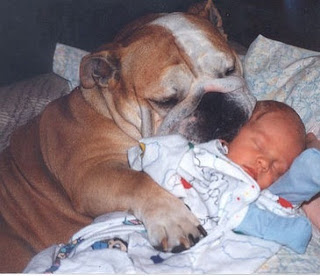ORIGIN: Many breeds we have covered are truly an "ancient breed", many dating back to the 1600's. The Border Collie, however, is not one of them. There are conflicting stories about exactly how this breed came to be. One reference stated it descends from a Viking herding dog used to herd Reindeer (which we found fascinating!) However, several other reliable sources stated this "sheep dog" originated in the British Isles, most likely from Scottish descent. What everyone seems to agree upon is the origination of the breed began in Northumberland along the borders of Scotland and England. It is believed one dominant breed used to create the Border Collie was the "landrace collie" and also some type of spaniel. One of the original Border Collies used as a main stud dog for the breed was "Old Help" (1893-1902). Old Hemp was a quiet, powerful dog that sheep responded to easily and whose working style became the Border Collie method. Every pure bred Border Collie alive today has a lineage connection to Old Hemp. Another famous Border Collie stud dog is Winston Cap (born 1963).
 INTERESTING INFO: Okay, we did NOT make up what you are about to read: The Border Collie literally has an eye that can "hypnotize" cattle and "mesmerize" sheep and other livestock. Their style of crouching down, and the ultra intense and penetrating stare of the Border Collie, enables them to control every animal they herd. They also have an extraordinary ear. A professional working Border Collie will take direction from the shepherd by a single voice or whistle command a long distance from the Shepherd (sometimes as far away as a mile!). Now it becomes more clear why this breed has been accused of being a mind reader! Border Collies (and other excellent sheepdogs) can easily do the work of three humans. While this breed is most famous for herding cattle and sheep, these skills are also used in controlling poultry, pigs and ostriches. Border Collies are also used to "herd off" unwanted wild birds from airport runways, golf courses and other areas. But herding is not the only job this extraordinarily intelligent breed can be used for. They've got a great set of springs and can easily out perform an NBA center at catching a frisbee! They excel (and usually win) agility competitions, and even perform exceptionally well in "dog dancing competitions" (nope, that was not a typo). As for professional human-assisting jobs, they can easily be trained for narcotics detection, search and rescue and some even perform well as guide dogs for the blind. Also, because they have a highly evolved sense of smell, they can compete in tracking trials. Wow! Quite an impressive resume of skills!
INTERESTING INFO: Okay, we did NOT make up what you are about to read: The Border Collie literally has an eye that can "hypnotize" cattle and "mesmerize" sheep and other livestock. Their style of crouching down, and the ultra intense and penetrating stare of the Border Collie, enables them to control every animal they herd. They also have an extraordinary ear. A professional working Border Collie will take direction from the shepherd by a single voice or whistle command a long distance from the Shepherd (sometimes as far away as a mile!). Now it becomes more clear why this breed has been accused of being a mind reader! Border Collies (and other excellent sheepdogs) can easily do the work of three humans. While this breed is most famous for herding cattle and sheep, these skills are also used in controlling poultry, pigs and ostriches. Border Collies are also used to "herd off" unwanted wild birds from airport runways, golf courses and other areas. But herding is not the only job this extraordinarily intelligent breed can be used for. They've got a great set of springs and can easily out perform an NBA center at catching a frisbee! They excel (and usually win) agility competitions, and even perform exceptionally well in "dog dancing competitions" (nope, that was not a typo). As for professional human-assisting jobs, they can easily be trained for narcotics detection, search and rescue and some even perform well as guide dogs for the blind. Also, because they have a highly evolved sense of smell, they can compete in tracking trials. Wow! Quite an impressive resume of skills!
HEALTH: Hip dysplasia, Collie eye anomaly, epilepsy and deafness top the list. Some herding dogs carry a certain MDR 1 gene that makes them hypersensitive to certain drugs. It's imperative if you have a herding breed to have them tested for this gene because many are killed by certain meds that other dogs do absolutely fine with.
IS THIS BREED A GOOD FIT FOR YOU? This breed requires a good amount of exercise. They usually do not do well in an apartment. They require leadership above and beyond most other breeds or they can become very neurotic and destructive. But for those who have been willing to make the time and commitment to this breed they all insist there's no going back. Border Collies are renowned for their loyalty, understanding and quick response to praise. We just wouldn't recommend a staring competition with one, or you might end up running around in your underwear flapping your arms and clucking like a chicken!
















